Dead or Alive: Drivers of Wind Mortality Initiate Multiple Disturbance Regime in a Temperate Primeval Mountain Forest
Abstract
:1. Introduction
2. Materials and Methods
2.1. Study Site
2.2. General Conceptual Model
2.3. Sampling Design and Data Processing
2.4. Site Hypothesis (H1)
2.5. Historical Hypothesis (H2)
2.6. Species Hypothesis (H3)
2.7. Size Hypothesis (H4)
2.8. Material Hypothesis (H5)
2.9. Statistical Analyses
3. Results
3.1. Site Hypothesis (H1)
3.2. Historical Hypothesis (H2)
3.3. Species Hypothesis (H3)
3.4. Size Hypothesis (H4)
3.5. Material Hypothesis (H5)
4. Discussion
4.1. Soil-Species Drivers of Wind Mortality Initiate Multiple Disturbance Regime
4.2. Disturbed Trees Experienced Different Disturbance History Than Survivors
4.3. Preceding Growth Rate Determines the Tendency of Trees toward Fall
4.4. Results in a Broad Context and Implications for Forest Management
5. Conclusions
Supplementary Materials
Author Contributions
Funding
Data Availability Statement
Acknowledgments
Conflicts of Interest
References
- Denslow, J.S.; Ellison, A.M.; Sanford, R.E. Treefall gap size effects on above- and below-ground processes in a tropical wet forest. J. Veg. Sci. 1998, 86, 597–609. [Google Scholar] [CrossRef]
- Brokaw, N.; Busing, R.T. Niche versus chance and tree diversity in forest gaps. Trends Ecol. Evol. 2000, 15, 183–188. [Google Scholar] [CrossRef]
- Ulanova, N.G. The effects of windthrow on forests at different spatial scales: A review. For. Ecol. Manag. 2000, 135, 155–167. [Google Scholar] [CrossRef]
- Franklin, J.F.; Spies, T.A.; Van Pelt, R.; Carey, A.B.; Thornburgh, D.A.; Berg, D.R.; Lindenmayer, D.B.; Harmon, M.E.; Keeton, W.S.; Shaw, D.C.; et al. Disturbances and structural development of natural forest ecosystems with silvicultural implications, using Douglas-fir forests as an example. For. Ecol. Manag. 2002, 155, 399–423. [Google Scholar] [CrossRef]
- Gray, A.N.; Spies, T.A.; Easter, M.J. Microclimatic and soil moisture responses to gap formation in coastal Douglas-fir forests. Can. J. For. Res. 2002, 32, 332–343. [Google Scholar] [CrossRef] [Green Version]
- Phillips, J.D.; Marion, D.A. Pedological memory in forest soil development. For. Ecol. Manag. 2004, 188, 363–380. [Google Scholar] [CrossRef] [Green Version]
- Splechtna, B.E.; Gratzer, G.; Black, B.A. Disturbance history of a European old-growth mixed-species forest—A spatial dendro-ecological analysis. J. Veg. Sci. 2005, 16, 511–522. [Google Scholar]
- Nagel, T.A.; Levanic, T.; Diaci, J. A dendroecological reconstruction of disturbance in an old-growth Fagus–Abies forest in Slovenia. Ann. For. Sci. 2007, 64, 891–897. [Google Scholar] [CrossRef]
- Kathke, S.; Bruelheide, H. Gap dynamics in a near-natural spruce forest at Mt. Brocken, Germany. For. Ecol. Manag. 2010, 259, 624–632. [Google Scholar] [CrossRef]
- Bottero, A.; Garbarino, M.; Dukic´, V.; Govedar, Z.; Lingua, E.; Nagel, T.A.; Motta, R. Gap-phase dynamics in the old-growth forest of Lom, Bosnia and Herzegovina. Silva Fennica 2011, 45, 875–887. [Google Scholar] [CrossRef] [Green Version]
- Firm, D.; Nagel, T.A.; Diaci, J. Disturbance history and dynamics of an old-growth mixed species mountain forest in the Slovenian Alps. For. Ecol. Manag. 2009, 257, 1893–1901. [Google Scholar] [CrossRef]
- Zielonka, T.; Holeksa, J.; Fleischer, P.; Kapusta, P. A tree-ring reconstruction of wind disturbances in a forest of the Slovakian Tatra Mountains, Western Carpathians. J. Veg. Sci. 2010, 21, 31–42. [Google Scholar] [CrossRef]
- Panayotov, M.; Kulakowski, D.; Laranjeiro Dos Santos, L.; Bebi, P. Wind disturbances shape old Norway spruce-dominated forest in Bulgaria. For. Ecol. Manag. 2011, 262, 470–481. [Google Scholar] [CrossRef]
- Svoboda, M.; Janda, P.; Nagel, T.A.; Fraver, S.; Rejzek, J.; Bače, R. Disturbance history of an old-growth sub-alpine Picea abies stand in the Bohemian Forest, Czech Republic. J. Veg. Sci. 2012, 23, 86–97. [Google Scholar] [CrossRef]
- Čada, V.; Morrissey, R.C.; Michalová, Z.; Bače, R.; Janda, P.; Svoboda, M. Frequent severe natural disturbances and non-equilibrium landscape dynamics shaped the mountain spruce forest in central Europe. For. Ecol. Manag. 2016, 363, 169–178. [Google Scholar] [CrossRef]
- Šamonil, P.; Doleželová, P.; Vašíčková, I.; Adam, D.; Valtera, M.; Král, K.; Janík, D.; Šebková, B. Individual-based approach to the detection of disturbance history through spatial scales in a natural beech-dominated forest. J. Veg. Sci. 2013, 24, 1167–1184. [Google Scholar] [CrossRef]
- Svoboda, M.; Janda, P.; Bače, R.; Fraver, S.; Nagel, T.A.; Rejzek, J.; Mikoláš, M.; Douda, J.; Boublík, K.; Šamonil, P.; et al. Landscape-level variability in historical disturbance in primary Picea abies mountain forests of the Eastern Carpathians, Romania. J. Veg. Sci. 2014, 25, 386–401. [Google Scholar] [CrossRef]
- Janda, P.; Trotsiuk, V.; Mikoláš, M.; Bače, R.; Nagel, T.A.; Seidl, R.; Seedre, M.; Morrissey, R.C.; Kucbel, S.; Jaloviar, P.; et al. The historical disturbance regime of mountain Norway spruce forests in the Western Carpathians and its influence on current forest structure and composition. For. Ecol. Manag. 2017, 388, 67–78. [Google Scholar] [CrossRef] [PubMed] [Green Version]
- Trotsiuk, V.; Svoboda, M.; Janda, P.; Mikolas, M.; Bace, R.; Rejzek, J.; Samonil, P.; Chaskovskyy, O.; Korol, M.; Myklush, S. A mixed severity disturbance regime in the primary Picea abies (L.) Karst. forests of the Ukrainian Carpathians. For. Ecol. Manag. 2014, 334, 144–153. [Google Scholar] [CrossRef]
- Kašpar, J.; Šamonil, P.; Vašíčková, I.; Dušan, A.; Daněk, P. Woody species-specific disturbance regimes and strategies in mixed mountain temperate forests in the Šumava Mts., Czech Republic. Eur. J. For. Res. 2020, 139, 97–109. [Google Scholar] [CrossRef]
- Canham, C.D.; Papaik, M.J.; Latty, E.F. Interspecific variation in susceptibility to windthrow as a function of tree size and storm severity for northern temperate tree species. Can. J. For. Res. 2001, 31, 1–10. [Google Scholar] [CrossRef]
- Nagel, T.A.; Diaci, J. Intermediate wind disturbance in an old-growth beech-fir forest in southwestern Slovenia. Can. J. For. Res. 2006, 36, 629–638. [Google Scholar] [CrossRef]
- Rich, R.L.; Frelich, L.E.; Reich, P.B. Wind-throw mortality in the southern boreal forest: Effects of species, diameter and stand age. J. Ecol. 2007, 95, 1261–1273. [Google Scholar] [CrossRef]
- Thom, D.; Seidl, R.; Steyrer, G.; Krehan, H.; Formayer, H. Slow and fast drivers of the natural disturbance regime in Central European forest ecosystems. For. Ecol. Manag. 2013, 307, 293–302. [Google Scholar] [CrossRef]
- Jactel, H.; Bauhus, J.; Boberg, J.; Bonal, D.; Castagneyrol, B.; Gardiner, B.; Gonzalez—Olabarria, J.R.; Koricheva, J.; Meurisse, N.; Brockerhoff, E.G. Tree diversity drives forest stand resistance to natural disturbances. Curr. For. Rep. 2017, 3, 223–243. [Google Scholar] [CrossRef]
- Nicoll, B.C.; Gardiner, B.A.; Rayner, B.; Peace, A.J. Anchorage of coniferous trees in relation to species, soil type, and rooting depth. Can. J. For. Res. 2006, 36, 1871–1883. [Google Scholar] [CrossRef]
- Papaik, M.J.; Canham, C.D. Species resistance and community response to wind disturbance regimes in Northern Temperate Forests. J. Ecol. 2006, 94, 1011–1026. [Google Scholar] [CrossRef]
- Rose, K.E.; Atkinson, R.L.; Turnbull, L.A.; Rees, M. The costs and benefits of fast living. Ecol. Lett. 2009, 12, 1379–1384. [Google Scholar] [CrossRef] [Green Version]
- Di Filippo, A.; Biondi, F.; Maugeri, M.; Schirone, B.; Piovesan, G. Bioclimate and growth history affect beech lifespan in the Italian Alps and Apennines. Glob. Chang. Biol. 2012, 18, 960–972. [Google Scholar] [CrossRef]
- Bigler, C.; Veblen, T.T. Increased Early Growth Rates Decrease Longevities of Conifers in Subalpine Forests. Oikos 2009, 118, 1130–1138. [Google Scholar] [CrossRef]
- Piovesan, G.; Biondi, F.; Baliva, M.; De Vivo, G.; Marchianò, V.; Schettino, A.; Di Filippo, A. Lessons from the wild: Slow but increasing long-term growth allows for maximum longevity in European beech. Ecology 2019, 100, e02737. [Google Scholar] [CrossRef]
- Pavlin, J.; Nagel, T.A.; Svitok, M.; Pettit, J.L.; Begović, K.; Mikac, S.; Dikku, A.; Toromani, E.; Panayotov, M.; Zlatanov, T.; et al. Disturbance history is a key driver of tree lifespan in temperate primary forests. J. Veg. Sci. 2021, 32, e13069. [Google Scholar] [CrossRef]
- Ray, D.; Nicoll, B.C. The effect of soil water-table depth on root plate development and stability of Sitka spruce. Forestry 1998, 71, 169–182. [Google Scholar] [CrossRef] [Green Version]
- Dobbertin, M. Influence of stand structure and site factors on wind damage comparing the storms Vivian and Lothar. For. Snow Landsc. Res. 2002, 77, 187–205. [Google Scholar]
- Frelich, L.E.; Ostuno, E.J. Estimating wind speeds of convective storms from tree damage. E-J. Sev. Storms Meteorol. 2012, 7, 1–19. [Google Scholar]
- Šamonil, P.; Král, K.; Hort, L. The role of tree uprooting in soil formation: A critical literature review. Geoderma 2010, 157, 65–79. [Google Scholar] [CrossRef]
- Daněk, P.; Šamonil, P.; Phillips, J.D. Geomorphic controls of soil spatial complexity in a primeval mountain forest in the Czech Republic. Geomorphology 2016, 273, 280–291. [Google Scholar] [CrossRef]
- Šamonil, P.; Valtera, M.; Bek, S.; Šebková, B.; Vrška, T.; Houška, J. Soil variability through spatial scales in a permanently disturbed natural spruce-fir-beech forest. Eur. J. For. Res. 2011, 130, 1075–1091. [Google Scholar] [CrossRef]
- Valtera, M.; Šamonil, P.; Boublík, K. Soil variability in naturally disturbed Norway spruce forests in the Carpathians: Bridging spatial scales. For. Ecol. Manag. 2013, 310, 134–146. [Google Scholar] [CrossRef]
- Daněk, P.; Šamonil, P.; Vrška, T. Four decades of the coexistence of beech and spruce in a Central European old-growth forest. Which succeeds on what soils and why? Plant. Soil 2019, 437, 257–272. [Google Scholar] [CrossRef]
- Šamonil, P.; Vašíčková, I.; Daněk, P.; Janík, D.; Adam, D. Disturbances can control fine-scale pedodiversity in old-growth forest: Is the soil evolution theory disturbed as well? Biogeosciences 2014, 11, 5889–5905. [Google Scholar] [CrossRef] [Green Version]
- Brázdil, R.; Dobrovolný, P.; Štekl, J.; Kotyza, O.; Valášek, H.; Jež, J. History of Weather and Climate in the Czech. Lands VI: Strong Winds; Masaryk University: Brno, Czech Republic, 2004. [Google Scholar]
- Brázdil, R.; Szabó, P.; Dobrovolný, P.; Řezníčková, L.; Kotyza, O.; Suchánková, S.; Valášek, H. Windstorm of the eighteenth century in the Czech Lands: Course, extent, impacts. Theory Appl. Climatol. 2017, 129, 623–632. [Google Scholar] [CrossRef]
- Brázdil, R.; Szabó, P.; Stucki, P.; Dobrovolný, P.; Řezníčková, L.; Kotyza, O.; Valášek, H.; Mělo, M.; Suchánková, S.; Dolák, L.; et al. The extraordinary windstorm of 7 December 1868 in the Czech Lands and its central European context. Int. J. Climatol. 2017, 37, 14–29. [Google Scholar] [CrossRef]
- Brázdil, R.; Stucki, P.; Szabó, P.; Řezníčková, L.; Dolák, L.; Dobrovolný, P.; Tolasz, R.; Kotyza, O.; Chromá, K.; Suchánková, S. Windstorms and forest disturbances in the Czech Lands: 1801–2015. Agric. For. Meteorol. 2018, 250–251, 47–63. [Google Scholar] [CrossRef]
- Brázdil, R.; Szabó, P.; Stucki, P.; Dobrovolný, P.; Řezníčková, L.; Kotyza, O.; Valášek, H.; Dolák, L.; Zahradníček, P.; Suchánková, S. The second most disastrous windstorm of the 19th century in the Czech Lands, 26–27 October 1870. Theory Appl. Climatol. 2018, 132, 1201–1216. [Google Scholar] [CrossRef]
- Vrška, T.; Hort, L.; Odehnalová, P.; Adam, D.; Horal, D. Boubin virgin forest after 24 years 1972–1996)—Development of tree layer. J. For. Sci. 2001, 47, 439–459. [Google Scholar]
- Bobek, P.; Svobodová-Svitavská, H.; Pokorný, P.; Šamonil, P.; Kuneš, P.; Kozáková, R.; Abraham, V.; Klinerová, T.; Švarcová, M.G.; Jamrichová, E.; et al. Divergent fire history trajectories in Central European temperate forests revealed a pronounced influence of broadleaved trees on fire dynamics. Quat. Sci. Rev. 2019, 222, 105865. [Google Scholar] [CrossRef]
- Šebková, B.; Šamonil, P.; Janík, D.; Adam, D.; Král, K.; Vrška, T.; Hort, L.; Unar, P. Spatial and volume patterns of an unmanaged submontane mixed forest in Central Europe: 160 years of spontaneous dynamics. For. Ecol. Manag. 2011, 262, 873–885. [Google Scholar] [CrossRef]
- Kašpar, K.; Tumajer, J.; Vašíčková, I.; Šamonil, P. Species-specific climate-growth interactions determine the future tree species dynamics of the mixed Central European mountain forests. Environ. Res. Lett. 2021, 16, 034039. [Google Scholar] [CrossRef]
- Šamonil, P.; Vrška, T. Long-term vegetation dynamics in the Šumava Mts. natural spruce-fir- beech forests. Plant. Ecol. 2007, 196, 197–214. [Google Scholar] [CrossRef]
- Michéli, E.; Schad, P.; Spaargaren, O. World Reference Base for Soil Resources 2006, First Update 2007; World Soil Resources Reports; FAO: Rome, Italy, 2007. [Google Scholar]
- Yamaguchi, D.K. A Simple Method for Cross-Dating Increment Cores from Living Trees. Can. J. For. Res. 1991, 21, 414–416. [Google Scholar] [CrossRef]
- Grissino-Mayer, H.D. Evaluating crossdating accuracy: A manual and tutorial for the computer program COFECHA. Tree-Ring Res. 2001, 57, 205–221. [Google Scholar]
- Lorimer, C.G.; Frelich, L.E.; Nordheim, E.V. Estimating Gap origin probabilities for canopy trees. Ecology 1988, 69, 778–785. [Google Scholar] [CrossRef] [Green Version]
- Black, B.A.; Abrams, M.D. Use of boundary-line growth patterns as a basis for dendroecological release criteria. Ecol. Appl. 2003, 13, 1733–1749. [Google Scholar] [CrossRef] [Green Version]
- Nowacki, G.J.; Abrams, M.D. Radial-growth averaging criteria for reconstructing disturbance histories from presettlement-origin oaks. Ecol. Monogrol. 1997, 67, 225–249. [Google Scholar] [CrossRef]
- Vašíčková, I.; Šamonil, P.; Ubilla, A.E.F.; Král, K.; Daněk, P.; Adam, D. The true response of Fagus sylvatica L. to disturbances: A basis for the empirical inference of release criteria for temperate forests. For. Ecol. Manag. 2016, 374, 174–185. [Google Scholar] [CrossRef]
- Lorimer, C.G.; Frelich, L.E. A Methodology for Estimating Canopy Disturbance Frequency and Intensity in Dense Temperate Forests. Can. J. For. Res. 1989, 19, 651–663. [Google Scholar] [CrossRef]
- Applequist, M.B. A simple pith locator for using with offcenter increment cores. J. For. 1958, 56, 141. [Google Scholar]
- Saranpää, P. Wood density and growth. In Wood Quality and Its Biological Basis; Barnett, J.R., Jeronimidis, G., Eds.; Blackwell: Oxford, UK, 2003; pp. 87–117. [Google Scholar]
- Schweingruber, F.H.; Fritts, H.C.; Bräker, O.U.; Drew, L.G.; Schär, E. The X-Ray technique as applied to dendroclimatology. Tree-Ring Bull. 1978, 38, 61–91. [Google Scholar]
- Campbell, R.; McCarroll, D.; Loader, N.J.; Grudd, H.; Robertson, I.; Jalkanen, R. Blue intensity in Pinus sylvestris tree-rings: Developing a new paleoclimate proxy. Holocene 2007, 17, 821–828. [Google Scholar] [CrossRef] [Green Version]
- Cook, E.R.; Kairiusktis, L.A. Methods of Dendrochronology: Applications in the Environmental Sciences; Kluwer Academic Publishers: Dordrecht, The Netherlands, 1990. [Google Scholar]
- Bunn, A.G. A dendrochronology program library in R (dplR). Dendrochronologia 2008, 26, 115–124. [Google Scholar] [CrossRef]
- Elling, W.; Dittmar, C.; Pfaffelmoser, K.; Rötzer, T. Dendroecological assessment of the complex causes of decline and recovery of the growth of silver fir (Abies alba Mill.) in Southern Germany. For. Ecol. Manag. 2009, 257, 1175–1187. [Google Scholar] [CrossRef]
- Cherubini, P.; Battipaglia, G.; Innes, J.L. Tree Vitality and Forest Health: Can Tree-Ring Stable Isotopes Be Used as Indicators? Curr. For. Rep. 2021, 7, 69–80. [Google Scholar] [CrossRef]
- Šamonil, P.; Daněk, P.; Schaetzl, R.J.; Tejnecký, V.; Drábek, O. Converse pathways of soil volution caused by tree uprooting: A synthesis from three regions with varying soil formation processes. Catena 2018, 161, 122–136. [Google Scholar] [CrossRef]
- Šamonil, P.; Daněk, P.; Lutz, J.A.; Anderson-Teixeira, K.J.; Jaroš, J.; Phillips, J.D.; Rousová, A.; Adam, D.; Larson, A.J.; Kašpar, J.; et al. Tree mortality may drive landscape formation: Comparative study from ten temperate forests. Ecosystems 2021, submitted. [Google Scholar]
- Martin, T.J.; Ogden, J. Wind damage and response in New Zealand forests: A review. N. Z. J. Ecol. 2006, 30, 295–310. [Google Scholar]
- Mayer, H.; Raupach, M.R.; Kohsiek, W.; Gardiner, B.; Clarke, J.A.; Amtmann, R.; Crowther, J.M.; Jarvis, P.G.; Milne, R. Windthrow. Philos. Trans. R. Soc. London. B Biol. Sci. 1989, 324, 267–281. [Google Scholar]
- Schaetzl, R.I.; Burns, S.F.; Johnson, D.L.; Small, T.W. Tree uprooting: Review of impacts on forest ecology. Vegetatio 1989, 79, 165–176. [Google Scholar] [CrossRef]
- Allen, J.R.L. Trees and their response to wind: Mid-Flandrian strong winds, Severn Estuary and inner Bristol Channel, southwest Britain. Philos. Trans. R. Soc. London. B Biol. Sci. 1992, 338, 335–364. [Google Scholar]
- Usbeck, T.; Wohlgemuth, T.; Dobbertin, M.; Pfister, C.; Bürgi, A.; Rebetez, M. Increasing storm damage to forests in Switzerland from 1858 to 2007. Agric. For. Meteorol. 2010, 150, 47–55. [Google Scholar] [CrossRef]
- Phillips, J.D.; Šamonil, P. Biogeomorphological domination of forest landscapes: An example from the Šumava Mountains, Czech Republic. Geomorphology 2021, 383, 107698. [Google Scholar] [CrossRef]
- Phillips, J.D.; Van Dyke, C. Geomorphological state-and-transition models. Catena 2017, 153, 168–181. [Google Scholar] [CrossRef]
- Foster, D.R. Species and stand response to catastrophic wind in central New England, USA. J. Ecol. 1988, 76, 135–151. [Google Scholar] [CrossRef]
- Everham, E.M.; Brokaw, N.V.L. Forest damage and recovery from catastrophic wind. Bot. Rev. 1996, 62, 113–185. [Google Scholar] [CrossRef]
- Koizumi, A.; Motoyama, J.-I.; Sawata, K.; Sasaki, Y.; Hirai, T. Evaluation of drag coefficients of poplar- tree crowns by a field test method. J. Wood Sci. 2010, 56, 189–193. [Google Scholar] [CrossRef]
- Albrecht, A.; Hanewinkel, M.; Bauhus, J.; Kohnle, U. How does silviculture affect storm damage in forests of south-western Germany? Results from empirical modeling based on long-term observations. Eur. J. For. Res. 2010, 131, 229–247. [Google Scholar] [CrossRef]
- Drobyshev, I.V. Regeneration of Norway spruce in canopy gaps in Sphagnum-Myrtillus old-growth forests. For. Ecol. Manag. 1999, 115, 71–83. [Google Scholar] [CrossRef]
- Roženbergar, D.; Stjepan, M.; Anić, I.; Diaci, J. Gap regeneration patterns in relationship to light heterogeneity in two old-growth beech—Fir forest reserves in South East Europe. Forestry 2007, 80, 431–443. [Google Scholar]
- Woodcock, D.W.; Shier, D. Does Canopy Position Affect Wood Specific Gravity in Temperate Forest Trees? Ann. Bot. Lond. 2003, 91, 529–537. [Google Scholar] [CrossRef] [PubMed] [Green Version]
- Renninger, H.J.; Gartner, B.L.; Meinzer, F.C. Effects of release from suppression on wood functional characteristics in young Douglas-fir and western hemlock. Can. J. For. Res. 2006, 36, 2038–2046. [Google Scholar] [CrossRef]
- Pretzsch, H.; Rais, A. Wood quality in complex forests versus even-aged monocultures: Review and perspectives. Wood Sci. Technol. 2016, 50, 845–880. [Google Scholar] [CrossRef]
- Scott, R.E.; Mitchell, S.J. Empirical modeling of windthrow risk in partially harvested stands using tree, neighborhood, and stand attributes. For. Ecol. Manag. 2005, 218, 193–209. [Google Scholar] [CrossRef]
- Peterson, C.J. Consistent influence of tree diameter and species on damage in nine eastern North America tornado blowdowns. For. Ecol. Manag. 2007, 250, 96–108. [Google Scholar] [CrossRef]
- Xi, W.; Peet, R.K.; Decoster, J.K.; Urban, D.L. Tree damage risk factors associated with large, infrequent wind disturbances of Carolina forests. Forestry 2008, 81, 317–334. [Google Scholar] [CrossRef] [Green Version]
- Nolet, P.; Doyon, F.; Bouffard, D. Predicting stem windthrow probability in a northern hardwood forest using a wind intensity bio-indicator approach. Open J. For. 2012, 2, 77–87. [Google Scholar] [CrossRef] [Green Version]
- Weidman, R.H. The windfall problem in the Klamath region, Oregon. J. For. 1920, 18, 837–843. [Google Scholar]
- Peterson, C.J.; Pickett, S.T.A. Treefall and resprouting following catastrophic windthrow in an old-growth hemlock-hardwoods forest. For. Ecol. Manag. 1991, 42, 205–217. [Google Scholar] [CrossRef]
- Cremer, K.W.; Borough, C.J.; McKinnell, F.H.; Carter, P.R. Effects of stocking and thinning on wind damage in plantations. N. Z. J. For. Sci. 1982, 12, 244–268. [Google Scholar]
- Sheffield, R.M.; Thompson, M.T. Hurricane Hugo Effects on South Carolina‘s Forest Resource; Research Paper SE-284; U.S.D.A. Forest Service: Asheville, NC, USA, 1992. [Google Scholar]
- Boucher, D.H.; Vandermeer, J.H.; Yih, K.; Zamora, N. Contrasting Hurricane Damage in Tropical Rain Forest and Pine Forest. Ecology 1990, 71, 2022–2024. [Google Scholar] [CrossRef]
- Meyer, F.D.; Paulsen, J.; Körner, C. Windthrow Damage in Picea Abies is Associated with Physical and Chemical Stem Wood Properties. Trees 2008, 22, 463–473. [Google Scholar] [CrossRef]
- Curtis, J. Some observations on wind damage. J. For. 1943, 41, 877–882. [Google Scholar]
- Brůna, J.; Wild, J.; Svoboda, M.; Heurich, M.; Müllerová, J. Impacts and underlying factors of landscape-scale, historical disturbance of mountain forest identified using archival documents. For. Ecol. Manag. 2013, 305, 294–306. [Google Scholar] [CrossRef]
- Webb, S.L. Contrasting windstorm consequences in two forests, Itasca State Park, Minnesota. Ecology 1989, 70, 1167–1180. [Google Scholar] [CrossRef]
- Putz, F.E.; Coley, P.D.; Lu, K.; Montalavo, A.; Aiello, A. Uprooting and snapping of trees: Structural determinants and ecological consequences. Canadian J. For. Res. 1983, 13, 1011–1020. [Google Scholar] [CrossRef]
- Forest Products Laboratory. Wood Handbook—Wood as an Engineering Material; General Technical Report FPR-GTR-113; US Department of Agriculture, Forest Service: Madison, WI, USA, 1999. [Google Scholar]
- Mäkinen, H.; Jaakkola, T.; Piispanen, R.; Saranpää, P. Predicting wood and tracheid properties of Norway spruce. For. Ecol. Manag. 2007, 241, 175–188. [Google Scholar] [CrossRef]
- Büntgen, U.; Krusic, P.J.; Piermattei, A.; Coomes, D.A.; Esper, J.; Myglan, V.S.; Kirdyanov, A.V.; Camarero, J.J.; Crivellaro, A.; Körner, C. Limited capacity of tree growth to mitigate the global greenhouse effect under predicted warming. Nat. Commun. 2019, 10, 2171. [Google Scholar] [CrossRef]
- Brienen, R.J.W.; Caldwell, L.; Duchesne, L.; Voelker, S.; Barichivich, J.; Baliva, M.; Ceccantini, G.; Di Filippo, A.; Helama, S.; Locosselli, G.M.; et al. Forest carbon sink neutralized by pervasive growth-lifespan trade-offs. Nat. Commun. 2020, 11, 424. [Google Scholar] [CrossRef] [PubMed]
- Leibundgut, H. Über Zweck und Methodik der Struktur und Zuwachsanalyse von Urwäldern. Schweiz Z. Forstwes 1959, 110, 111–124. [Google Scholar]
- Korpel’, S. Die Urwälder der Westkarpaten; Gustav Fischer Verlag: Stuttgart, Germany, 1995. [Google Scholar]
- Mikoláš, M.; Ujházy, K.; Jasík, M.; Wiezik, M.; Gallay, I.; Polák, P.; Vysoký, J.; Čiliak, M.; Meigs, G.W.; Svoboda, M.; et al. Primary forest distribution and representation in a Central European landscape: Results of a large-scale field-based census. For. Ecol. Manag. 2019, 449, 117466. [Google Scholar] [CrossRef]
- Bebi, P.; Seidl, R.; Motta, R.; Fuhr, M.; Firm, D.; Krumm, F.; Conedera, M.; Ginzler, C.; Wohlgemuth, T.; Kulakowski, D. Changes of forest cover and disturbance regimes in the mountain forests of the Alps. For. Ecol. Manag. 2017, 388, 43–56. [Google Scholar] [CrossRef] [Green Version]
- Nagel, T.A.; Svoboda, M.; Kobal, M. Disturbance, life history traits, and dynamics in an old-growth forest landscape of southeastern Europe. Ecol. Appl. 2014, 24, 663–679. [Google Scholar] [CrossRef] [PubMed]
- Vacchiano, G.; Garbarino, M.; Lingua, E.; Motta, R. Ecology of mountain forest ecosystems in the Italian Apennines. For. Ecol. Manag. 2017, 388, 57–66. [Google Scholar] [CrossRef] [Green Version]
- Möller, A. Der Dauerwaldgedanke: Sein Sinn und Seine Bedeutung; Springer: Berlin/Heidelberg, Germany, 1922. [Google Scholar]
- Altman, J.; Fibich, P.; Doležal, J.; Aakala, T. TRADER: A package for Tree Ring Analysis of Disturbance Events in R. Dendrochronologia 2014, 32, 107–112. [Google Scholar] [CrossRef]
- Webster, R.; Oliver, M. Geostatistics for Environmental Scientists Statistics in Practice; Wiley: Chichester, UK, 2001. [Google Scholar]
- Minasny, B.; McBratney, A.B. The Matérn function as a general model for soil variograms. Geoderma 2005, 128, 192–207. [Google Scholar] [CrossRef]
- Carr, J.R.; Bailey, R.E.; Deng, E.D. Use of indicator variograms for an enhanced spatial analysis. Math. Geol. 1985, 17, 797–811. [Google Scholar] [CrossRef]

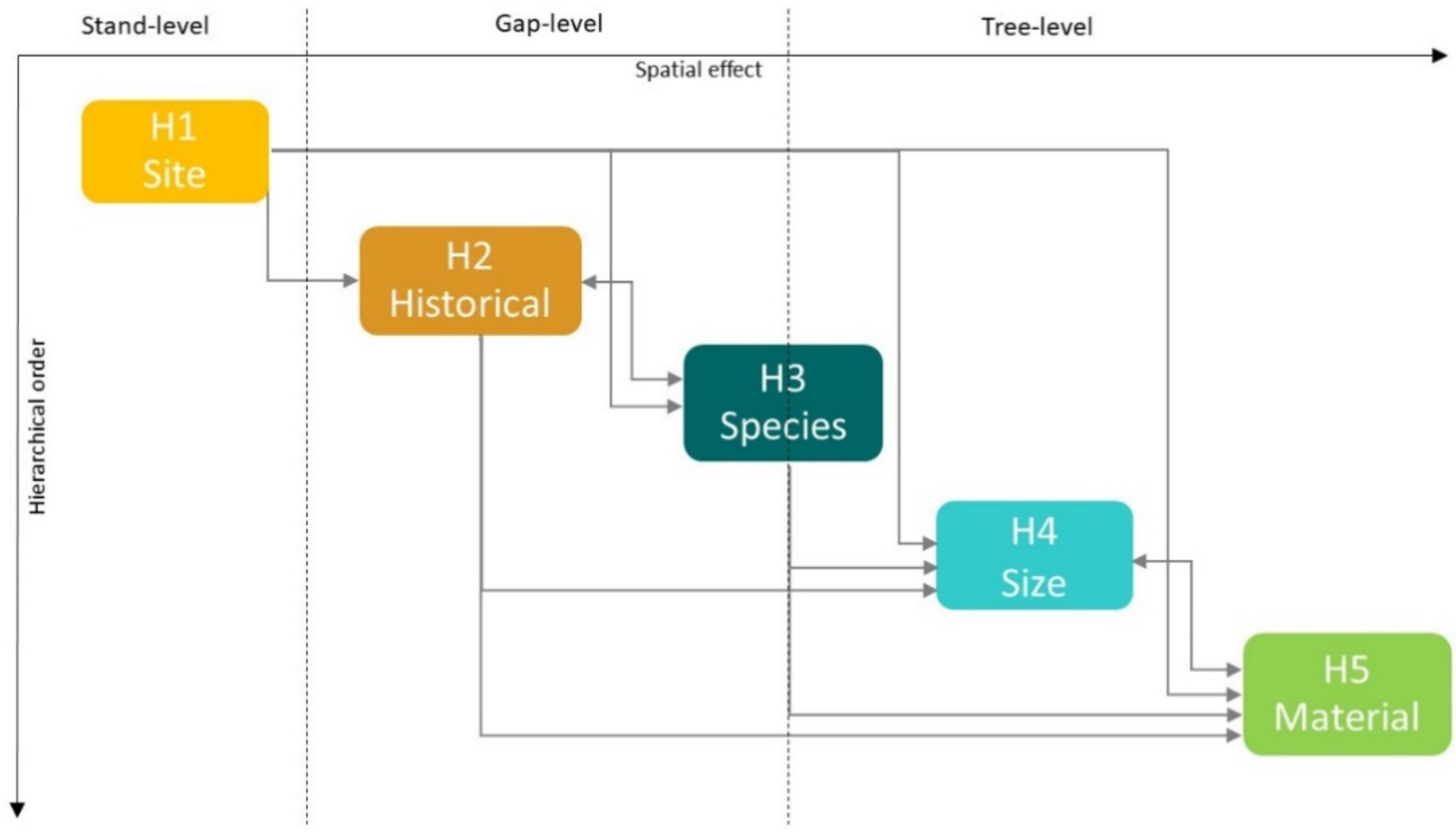
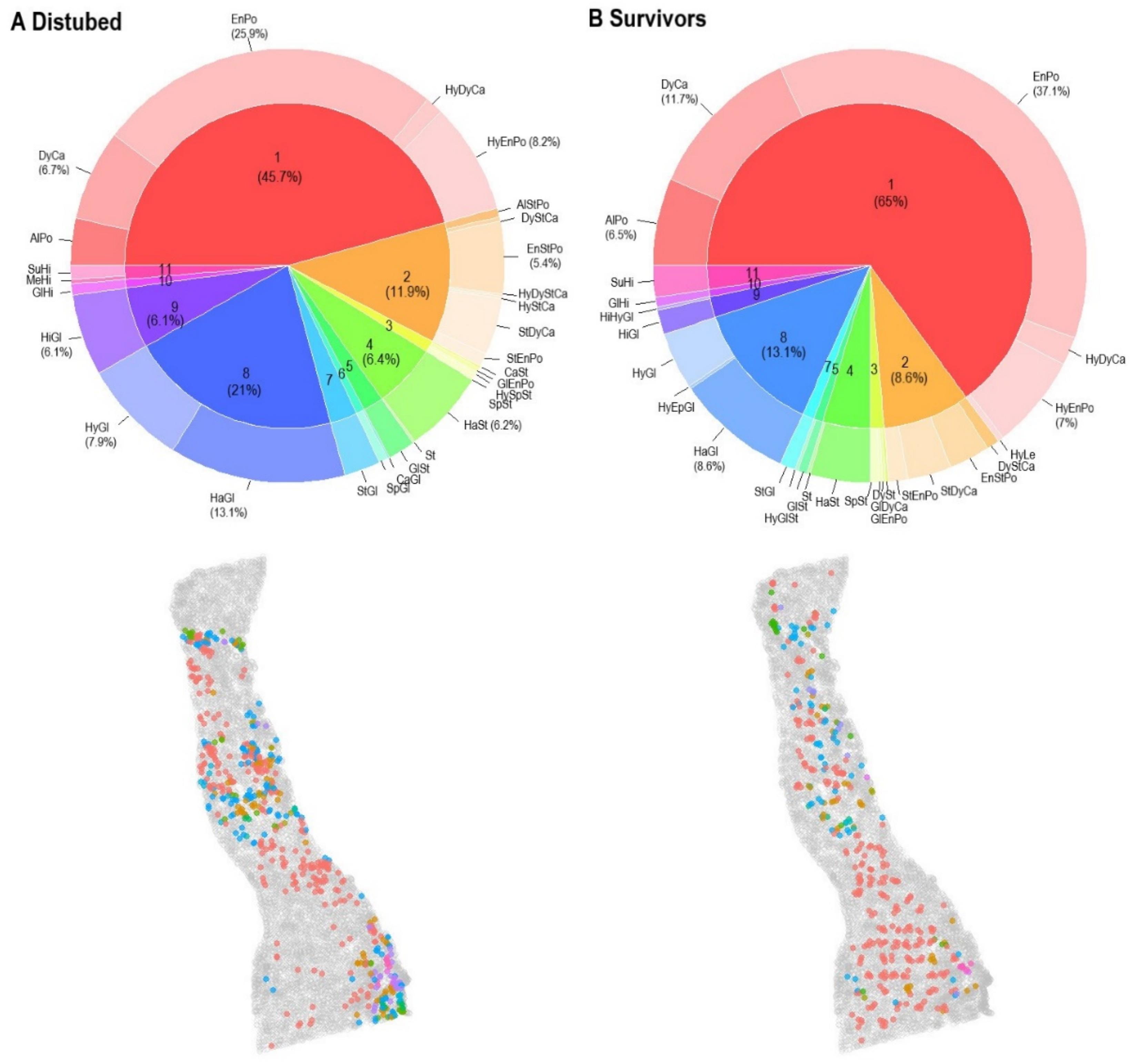
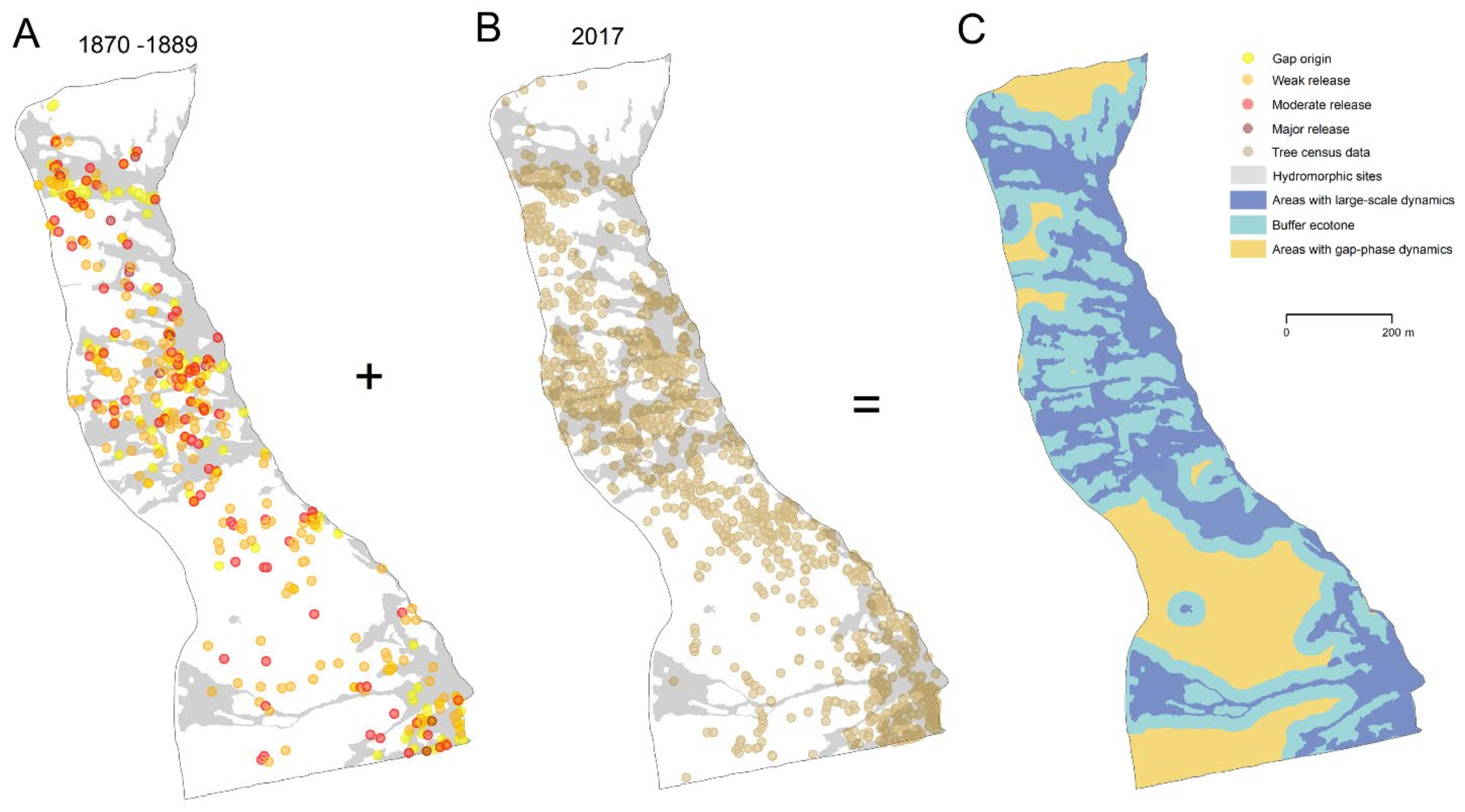
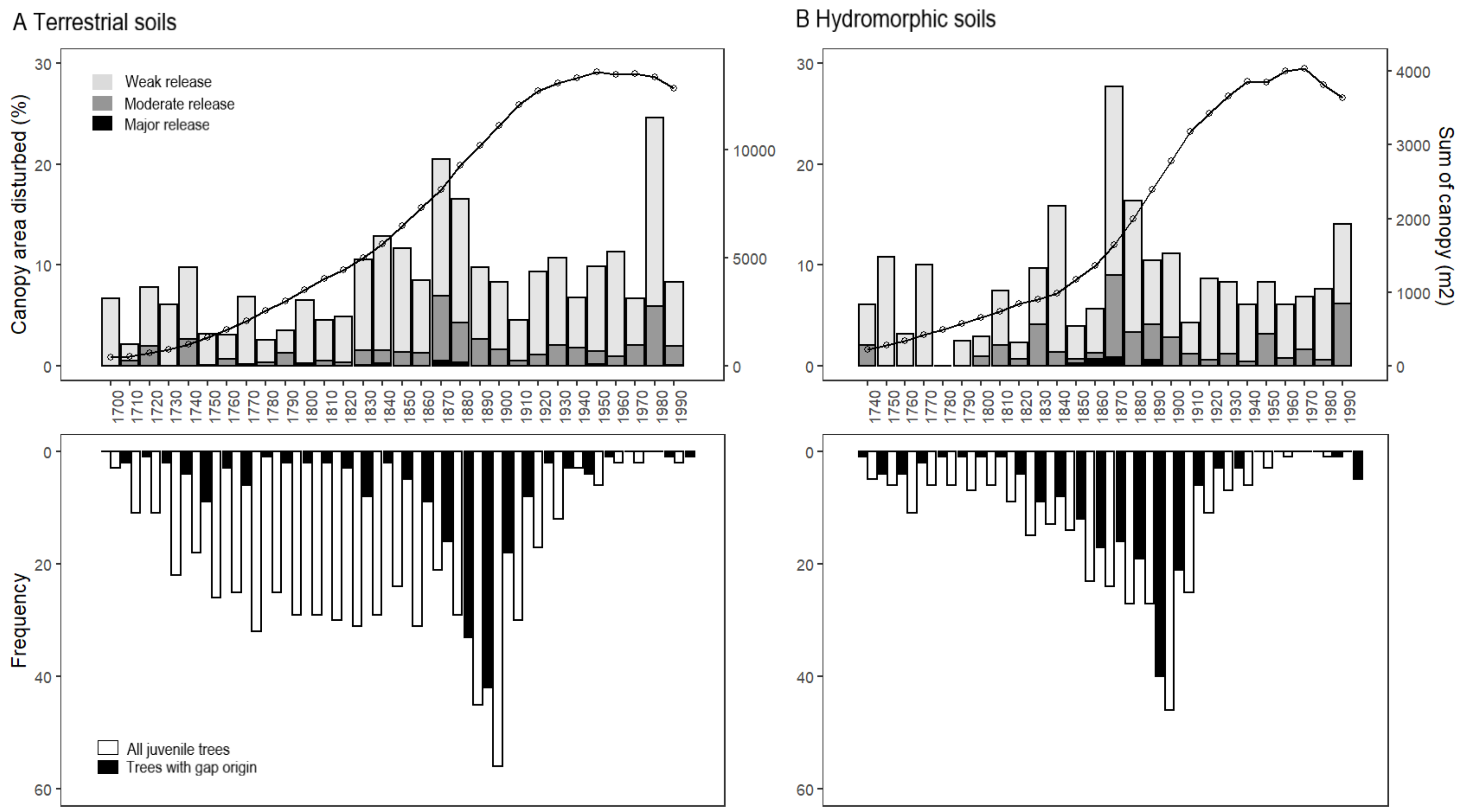
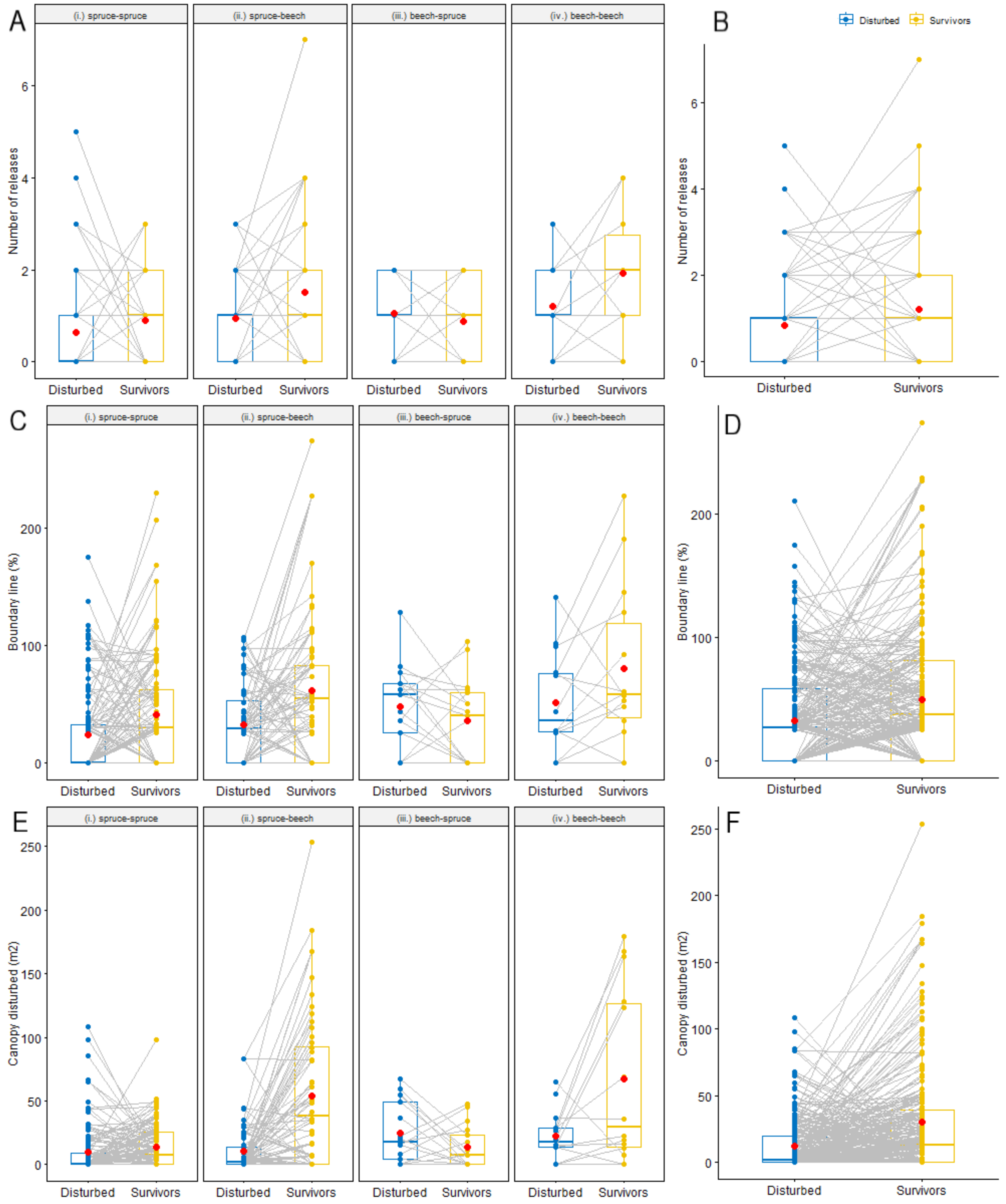
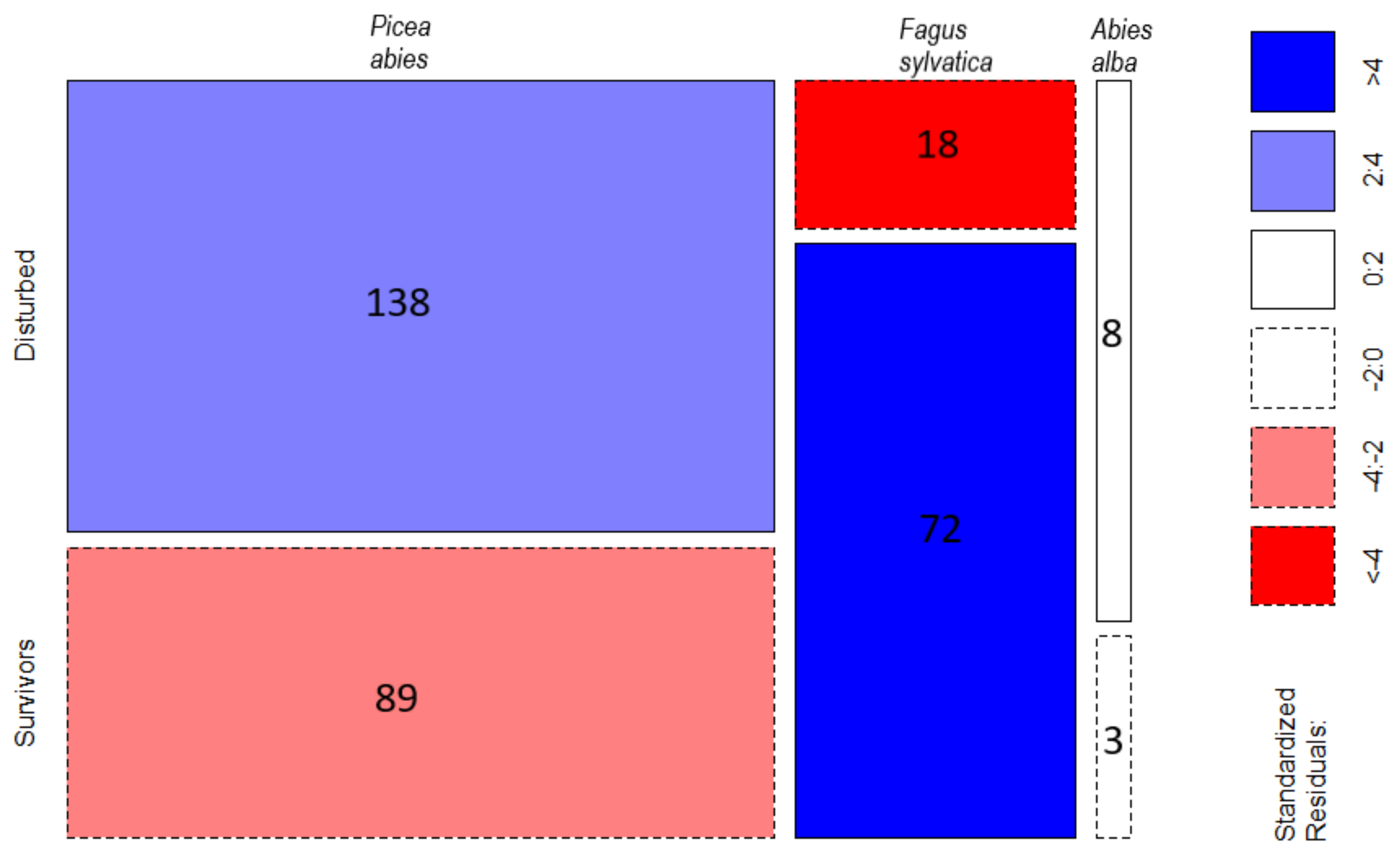
| Hypothesis | H1 Site | H2 Historical | H3 Species | H4 Size | H5 Material |
|---|---|---|---|---|---|
| Spatial effect | Stand-level | Gap-level | Gap-/Tree-level | Tree-level | Tree-level |
| Approach | Dendrochronology | Dendrochronology | Tree census | Tree census | Dendrochronology |
| Soil science | Dendrochronology | ||||
| Geostatistics | |||||
| Sample size N | 1061 cores | 271 pairs (release) | 271 pairs | 271 pairs (DBH) | 271 pairs |
| 954 soil profiles | 221 pairs (gap origin) | 221 pairs (age) | |||
| Statistical test | Mann-Whitney | Paired t-test (release) | Chi-sqare test | Paired t-test | Paired t-test |
| McNemar’s test (gap origin) |
| Variable. | Min | Max | Mean | Median | SD | 95% CI | Type of Paired Test | Sample Size | All Species | Spruce-Spruce | Spruce-Beech | Beech-Spruce | Beech-Beech |
|---|---|---|---|---|---|---|---|---|---|---|---|---|---|
| No. of releases ≥25% boundary line per tree | |||||||||||||
| Disturbed | 0 | 5 | 0.85 | 1 | 0.96 | 0.73–0.96 | - | 271 | - | - | - | - | - |
| Survivors | 0 | 7 | 1.20 | 1 | 1.18 | 1.06–1.34 | - | 271 | - | - | - | - | - |
| Difference | - | - | - | −0.50 | - | −0.99–−˂0.001 | Wilcoxon test | 542 | <0.001 | 0.005 | <0.001 | 0.523 | 0.086 |
| No. of releases ≥ 50% boundary line per tree | |||||||||||||
| Disturbed | 0 | 2 | 0.19 | 0 | 0.44 | 0.14–0.24 | - | 271 | - | - | - | - | - |
| Survivors | 0 | 3 | 0.37 | 0 | 0.67 | 0.29–0.45 | - | 271 | - | - | - | - | - |
| Difference | - | - | - | −0.50 | - | −0.99–−˂0.001 | Wilcoxon test | 542 | <0.001 | <0.001 | 0.012 | 0.233 | 0.280 |
| Total sum of boundary line (%) per tree | |||||||||||||
| Disturbed | 0 | 210.93 | 32.94 | 26.71 | 40.32 | 28.12–37.76 | - | 271 | - | - | - | - | - |
| Survivors | 0 | 274.11 | 49.78 | 37.64 | 54.60 | 43.25–56.31 | - | 271 | - | - | - | - | - |
| Difference | - | - | - | −22.14 | - | −30.63–−12.41 | Wilcoxon test | 542 | <0.001 | <0.001 | <0.001 | 0.293 | 0.108 |
| Total sum of canopy area disturbed (m2) | |||||||||||||
| Disturbed | 0 | 108.42 | 12.34 | 1.76 | 19.71 | 9.98–14.70 | - | 271 | - | - | - | - | - |
| Survivors | 0 | 253.61 | 30.49 | 13.18 | 43.20 | 25.32–35.66 | - | 271 | - | - | - | - | - |
| Difference | - | - | - | −17.66 | - | −23.61–−12.14 | Wilcoxon test | 542 | <0.001 | 0.002 | <0.001 | 0.148 | 0.030 |
| Gap origin | |||||||||||||
| Disturbed | - | - | - | - | - | - | - | 221 | - | - | - | - | - |
| Survivors | - | - | - | - | - | - | - | 221 | - | - | - | - | - |
| Difference | - | - | - | - | - | - | McNemar’s test | 442 | <0.001 | 0.091 | <0.001 | 0.617 | 1 |
| Diameter at breast height (cm) | |||||||||||||
| Disturbed | 10 | 110 | 51.99 | 52 | 23.90 | 49.13–54.84 | - | 271 | - | - | - | - | - |
| Survivors | 10 | 129 | 61.75 | 58 | 23.55 | 58.94–64.57 | - | 271 | - | - | - | - | - |
| Difference | - | - | - | −9.50 | - | −13.50–−5.50 | Wilcoxon test/t-test | 542 | <0.001/- | <0.001/- | 0.048/- | -/<0.001 | -/0.436 |
| Age at breast height (yrs) | |||||||||||||
| Disturbed | 32 | 567 | 201 | 178 | 84.94 | 190.17–212.69 | - | 221 | - | - | - | - | - |
| Survivors | 34 | 428 | 228 | 235 | 81.02 | 216.97–238.45 | - | 221 | - | - | - | - | - |
| Difference | - | - | - | −30.50 | - | −43.00–−17.50 | Wilcoxon test/t-test | 442 | <0.001/- | 0.012/- | -/<0.001 | -/0.070 | -/1 |
| Tree-ring width (RWI) | |||||||||||||
| Disturbed | 0.51 | 1.09 | 0.93 | 0.95 | 0.09 | 0.92–0.94 | - | 271 | - | - | - | - | - |
| Survivors | 0.58 | 1.05 | 0.87 | 0.89 | 0.10 | 0.86–0.89 | - | 271 | - | - | - | - | - |
| Difference | - | - | - | 0.05 | - | 0.04–0.07 | Wilcoxon test/t-test | 542 | <0.001/- | <0.001/- | <0.001/- | -/0.483 | -/0.030 |
| Soil Hydromorphism | Release Intensity | Model | AIC | Range (m) | Nugget | Sill |
|---|---|---|---|---|---|---|
| Hydromorphic | Weak | Stable | −34.754 | 18.783 | 0.046 | 0.239 |
| Moderate and major | Gaussian | −62.749 | 20.871 | 0.032 | 0.117 | |
| Terrestrial | Weak | Exponential | −44.706 | 11.005 | <0.001 | 0.229 |
| Moderate and major | Exponential | −79.914 | 8.040 | <0.001 | 0.117 |
Publisher’s Note: MDPI stays neutral with regard to jurisdictional claims in published maps and institutional affiliations. |
© 2021 by the authors. Licensee MDPI, Basel, Switzerland. This article is an open access article distributed under the terms and conditions of the Creative Commons Attribution (CC BY) license (https://creativecommons.org/licenses/by/4.0/).
Share and Cite
Vašíčková, I.; Šamonil, P.; Kašpar, J.; Román-Sánchez, A.; Chuman, T.; Adam, D. Dead or Alive: Drivers of Wind Mortality Initiate Multiple Disturbance Regime in a Temperate Primeval Mountain Forest. Forests 2021, 12, 1599. https://doi.org/10.3390/f12111599
Vašíčková I, Šamonil P, Kašpar J, Román-Sánchez A, Chuman T, Adam D. Dead or Alive: Drivers of Wind Mortality Initiate Multiple Disturbance Regime in a Temperate Primeval Mountain Forest. Forests. 2021; 12(11):1599. https://doi.org/10.3390/f12111599
Chicago/Turabian StyleVašíčková, Ivana, Pavel Šamonil, Jakub Kašpar, Andrea Román-Sánchez, Tomáš Chuman, and Dušan Adam. 2021. "Dead or Alive: Drivers of Wind Mortality Initiate Multiple Disturbance Regime in a Temperate Primeval Mountain Forest" Forests 12, no. 11: 1599. https://doi.org/10.3390/f12111599
APA StyleVašíčková, I., Šamonil, P., Kašpar, J., Román-Sánchez, A., Chuman, T., & Adam, D. (2021). Dead or Alive: Drivers of Wind Mortality Initiate Multiple Disturbance Regime in a Temperate Primeval Mountain Forest. Forests, 12(11), 1599. https://doi.org/10.3390/f12111599






